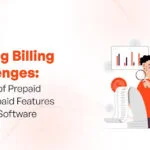These are some of the most common questions many business owners and professional service providers frequently ask while looking for IP PBX software solutions.
That’s because they want to make sure that the billing plan they choose is just perfect for their business.
If you are in the same boat, then this blog post is quite useful for you. In this, we will discuss the billing challenges that businesses using traditional communication systems face in today’s time.
So, without further ado, let’s dive right into the blog post and understand the role and benefits of prepaid and postpaid billing options in IP PBX systems. Read on and you will be glad that you did!
Billing Challenges in IP PBX Software
Traditional telecommunication billing systems, especially when it comes to IP PBX systems, have several challenges. Some of those are:
1. Billing Errors
Billing errors are one of the biggest challenges in the telecom sector. A study conducted by Gartner found that 85 percent of telecom invoices contain errors. That’s one of the major shortcomings of traditional telecom systems’ complex billing processes!
The sure-shot way of sending accurate invoices based on actual usage is by using sophisticated telecom solutions such as the right IP PBX software. It facilitates accurate financial reporting.
2. Variable Costs
In traditional billing and invoicing, variable costs are a major headache for businesses and individuals. Just put yourself in the shoes of a business owner who receives wildly varying invoices one month after the other.
For instance, if the invoice amount is a hundred dollars for one month and three hundred the next, just imagine the frustration and confusion the individual goes through! That’s the biggest challenge in traditional billing systems!
3. Lack of Transparency
In traditional invoicing, the lack of transparency is one of the major challenges and disadvantages!
The complex billing processes make it extremely difficult for customers to know their actual usage and what’s the actual amount of money they should be paying for the services and resources they’ve availed.
4. Lack of Flexibility
This study’s findings will shock you! The poll found out that two out of every five respondents said that their telecom bills made them feel helpless.
Three out of every five respondents aired grievances about the lack of flexibility on payment options.
5. No Mechanism for Cost Control
For online business, controlling avoidable costs is a must to prevent revenue leakage and losing competitive edge. However, traditional billing processes don’t enable cost control.
For professional service providers, unpredictable expenses can be a major source of several problems.
Prepaid Billing in IP PBX
Almost everyone (except toddlers) knows what prepaid billing is. It’s currently the most popular payment plan for mobile users.
So, as you already know, prepaid is “pay first and use later!” In some cases, it may come with an expiry date or validity period.
For instance, some prepaid phone plans require users to use the available services by a specific date. In that case, it’s “pay now and use within a certain date.”
The Benefits of Prepaid Plan for Businesses
The “pay now & use later” concept of prepaid billing has many advantages over its postpaid counterparts. Some of those are as follows:
1. Predictable Expenses
Predictability may be boring. In certain things, however, it can be good. In the words of noted educator Magda Gerber, “Predictability brings about security.”
Prepaid plans are predetermined and predictable. That gives users a clear idea about how much they are going to spend on communication. When expenses are predictable it becomes a massive advantage rather than a shortcoming.
2. Zero Risk of Non-payment or Late Payment
The risk of non-payment is a major concern in the telecom sector as well as other businesses. So is the risk of late payment. According to a Clockify study 55 percent of all invoices in the United States are paid late!
Just put yourself in the shoes of a business which receives late payment for more than half of invoices! Isn’t that horrifying? If you would never want to put yourself in a situation like that it’s prudent to go for a prepaid plan.
3. Simplified Billing Systems
There are several quotes on simplicity. For some it’s the ultimate sophistication. For some it’s elegance. For some it’s the key to brilliance. For contemporary businesses, simplicity is the road to success!
Being highly simple, prepaid plans reduce the complexity associated with billing and payment. They work like a charm for those organizations that not only look for predictable expenses and cost control but also for those companies that already have too many complexities in their processes.
When such organizations avail prepaid billing, they make sure that their services are not interrupted due to non-payment or late payment. Rather, they can rest assured and use the services they’ve already paid for upfront till the expiry date.
4. More Control Over Expenses
Would it be surprising to hear that prepaid billing plans can enable organizations to have more control over their expenses?
When an organization (a business) already knows the exact amount of money they are going to pay at the start of every billing cycle and the services they are going to get in return, wouldn’t they be in a better position to control their costs and expenditures? Obviously, they would.
Postpaid Billing in IP PBX
This is the oldest type of billing as far as the telecom industry is concerned. If you ever had a PSTN telephone, you would be familiar with this type of plan. Before the advent of cellular phones and prepaid calling cards and calling plans, a majority of businesses and individuals would first use the telephony services and they would get the bills later.
It also reminds of the times when some of us would be taken aback by the bills and it made us wonder how many calls did we make and where did we call that resulted in the bill! Jokes apart, even as some organizations prefer prepaid billing to the postpaid ones, the latter still is popular among many organizations and individuals due to its role and benefits.
The Benefits of Prepaid Plan for Businesses
Now that we have already established the benefits of postpaid billing, let’s get straight to the point!
1. Recurring Revenue
In the prepaid model, there is no guarantee that a customer will come back after the expiration of the validity period or service date. In the absence of heavy investment, customers may switch to a different service provider if they find cheaper plans. It’s extremely common in the case of mobile phone prepaid plans. It’s also not uncommon to find some customers not recharging regularly.
However, that’s not the case with postpaid billing. Compared to its prepaid counterpart, postpaid billing ensures a recurring revenue model for businesses. A popular anonymous quote on recurring revenue is, “in the SaaS world, recurring revenue is the king.” NSCA’s Executive Director Chuck Wilson also second that when he said, “Adding a recurring revenue model that naturally adds customer value is critical to the overall business health of a systems integrator.”
2. Longer-term Customer Relationship
The question may immediately come to your mind “What postpaid billing has got to do with customer relationships?” The answer is, a lot! Postpaid billing helps organizations ensure longer-term customer relationships in multiple ways. Let’s discuss those.
Organizations that opt for postpaid plans get a wide range of special benefits from service providers. It applies particularly to those organizations that pay their bills in a timely manner. It’s quite similar to credit card users with high credit scores. Another benefit is, as service providers have recurring transactions and communication with postpaid users, it gives them the chance to upsell and cross-sell their services.
All In All,
When it comes to the types of billing, organizations have two options to choose from. Prepaid and postpaid billing. Both have their benefits and roles for different types of organizations. And decision makers should weigh the pros and cons before making an investment decision.



